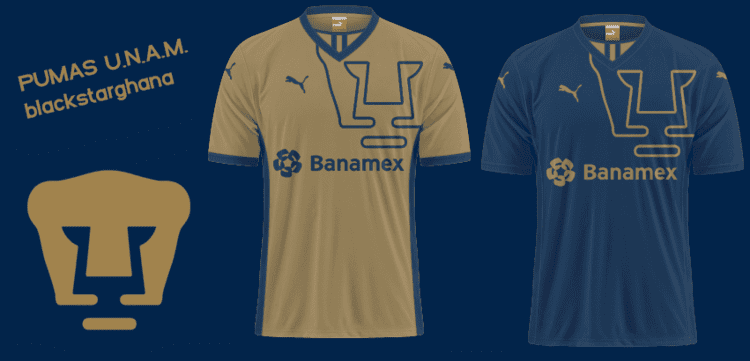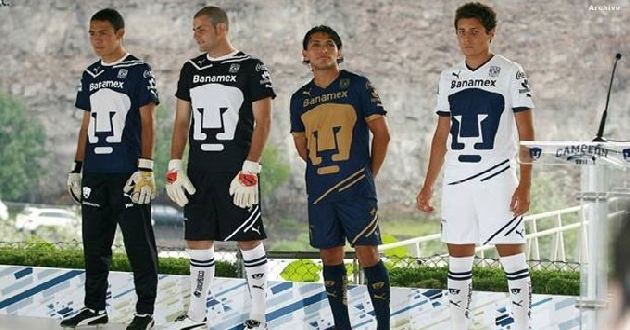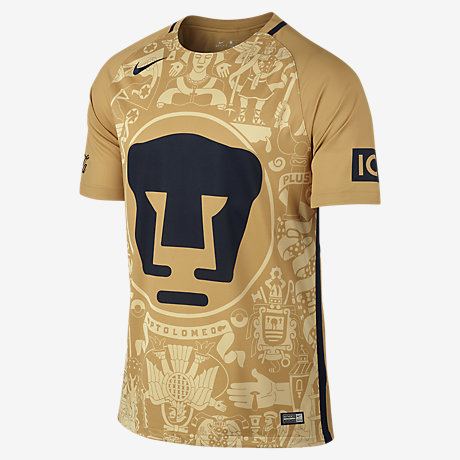Ground Capacity 48,297 Chairman Rodrigo Ares de Parga Founded 1954 | Owner UNAM | |
 | ||
Full name Club de Fútbol Universidad Nacional A. C. Nickname(s) Los Pumas (The Pumas)La Universidad (The University)La Banda del Pedregal (The Pedregal Gang) Profiles | ||
suscr bete canal oficial del club universidad nacional a c
Club de Fútbol Universidad Nacional A. C., commonly known as Pumas de la UNAM, Pumas UNAM ,U.N.A.M., or just as Pumas, is a Mexican league football club based in Ciudad Universitaria. Club Universidad Nacional represents the National Autonomous University of Mexico (UNAM), and plays their home matches at Olímpico Universitario Stadium, located on UNAM's main campus.
Contents
- suscr bete canal oficial del club universidad nacional a c
- Himno del club universidad nacional a c pumas unam
- Los Pumas
- History
- Establishment 1950s
- The promotion 1960s
- The legend begins 1970s
- Consolidation 1980s
- Ups and downs 1990s
- Success 2000s
- Rivalries
- Clsico Capitalino
- UNAM vs Cruz Azul
- Clsico Universitario
- UNAM vs Guadalajara
- Past kits
- Domestic tournaments
- International tournaments
- Friendly tournaments
- First team squad
- Retired numbers
- Reserve teams
- References

Universidad Nacional is one of the most popular clubs in Mexico. They have won seven Primera División championships and four international titles. The team is also known for their youth development system which has produced international players such as Hugo Sánchez, Manuel Negrete, Luis Flores, Claudio Suárez, Luis García, Alberto García Aspe, David Patiño, Jorge Campos, Gerardo Torrado, Efraín Juárez, Héctor Moreno, and Pablo Barrera.

Himno del club universidad nacional a c pumas unam
Los Pumas

Club Universidad Nacional was originally an amateur club of college students from the University's several schools and then developed into a professional team competing in the Mexican football league. UNAM have evolved into one of the most popular Mexican teams and have gained an international following.

The team's blue and gold colors were selected as a tribute to the University of Notre Dame, whose football coaches helped to develop an American-style football team at the university. The nickname was inspired by Roberto 'Tapatio' Mendez, who coached the team from 1946–64 and whose motivational speeches often compared his players to pumas. The nickname stayed with the public, and all the athletic teams representing the University have been called Pumas.
Their home ground is the Estadio Olímpico Universitario, the setting for the 1968 Summer Olympic Games. It has a seating capacity of over 58,000. Olympic Academic Stadium is situated within the University campus which enables easy access by the University students. The Pumas have training facilities within the University campus but their main complex is the Cantera, located near the University.
History
The dean of the University, Luis Chico Goerne, made the first attempt to affiliate a representative of UNAM to the top football Mexican championship of the day, by filing a petition to join the Liga Mayor de Fútbol Professional del Distrito Federal. The petition was rejected in favor of Club Marte de Morelos.
By the 1940s, the dean Gustavo Baz Prada assigned the task to prepare the UNAM representative to Rodolfo "Butch" Muñoz, then player of Club España. The new manager formed its new team with members of the student body of the many schools and faculties of the university. The UNAM representative joined many university tournaments, with successful results, and "Butch" Muñoz went on to manage the team for 13 years. This prepared the team to complete their later transition to professional status.
Establishment: 1950s
In August 1954, the Club Universidad was accepted as a member of the Segunda División, in those days the second tier division of professional football in Mexico. This achievement was accomplished with the support of the dean Nabor Carrillo and Guillermo Aguilar Alvarez Sr., a benefactor of the club. Aguilar Alvarez was appointed by the dean as the chairman of the club.
On September 12, 1954 UNAM played its first professional game, an away match against Monterrey. After competing for three years, Club Universidad requested a one-year moratorium in its competing in Segunda División play to undergo a programme rebuilding process. Within that year this was accomplished. Hector Ortiz was appointed as the new manager of the club, and a Board of Patrons was formed.
The promotion: 1960s
UNAM realized its objective of promotion from Segunda División to Primera División when Club Universidad won the home-played promotion match on January 9, 1962 by defeating Club Cataluña de Torreón, 9–1. The match ended, the students rushed the pitch, and honored its team by carrying them off the field on their shoulders—this was the first step towards the consolidation of the club.
The following day, dean Ignacio Chávez Sánchez congratulated the team when he met with them: Octavio Vial (manager), and players: Homero Villar, Raúl Chanes, José Antonio "La Espátula" Rodríguez, Rafael Ramirez Jimenez, Alfredo Echávarri, José Ruiz, Carlos Gutierrez, Alfredo "Tito" Zenteno, José Luis "El Chango" Ledezma, Antonio Sámano, Jorge Gaitán, Guillermo Vázquez Sr., José Luis González "La Calaca", Lorenzo Garcia, Carlos Calderón de la Barca, Manuel "Manolo" Rodríguez, Edmundo "El Poli" Pérez, and Gustavo "El Gato" Cuenca.
The team established itself in the Primera División, the Board of Patrons prepared for the continuation of the team's success by establishing youth system to develop new players.
The legend begins: 1970s
After two years under the management of Alfonso "El Pescado" Portugal, the Spaniard Ángel Zubieta took the reins of the team. This enabled the program to identify "foreign" reinforcements, but rely on promoting from the youth system.
The first half of the decade was marked by the arrival of three of the most important foreign players in the existence of the club; the Peruvian Juan José Muñante, the Serbian Velibor "Bora" Milutinović, and the Brazilian Cabinho. They arrived to join a solid base of native-players such as Miguel Mejía Barón, Héctor Sanabria, Arturo Vázquez Ayala, José Luis "Pareja" López, and Leonardo Cuellar. In the second half of the decade those same players would give the club its first titles in the top division.
In 1975 the club adopted a new administration consisting of an independent civil association that helped the University to support the club. In the 1974–75 season, Universidad won the Copa México and the Campeón de Campeones. In the 1976–77 season, Club Universidad became league champion for the first time in its history. That championship was followed by two sub championships. The culmination of a successful decade for Club Universidad came with the debut of Hugo Sánchez.
Consolidation: 1980s
In the 1980–81 season, Universidad won its second league championship. That season was also the last season Hugo Sánchez played for the club. In the following season, the Pumas won the CONCACAF Championship and the Interamerican Cup.
This decade also marked the national recognition of the work performed by the club, and the revolutionary and dynamic style of play that helped Mexican football overall. For the 1986 FIFA World Cup, the Mexican Football Federation appointed the manager of Universidad, Velibor "Bora" Milutinović as the manager of the Mexico national football team. Milutinović called numerous Pumas and former Pumas to the nation team, including Hugo Sánchez, Félix Cruz Barbosa, Rafael Amador, Raúl Servín, Miguel España, Manuel Negrete and Luis Flores. This generation of players gave great satisfactions not only to the followers of Pumas, but also to the Mexican football fans.
Ups and downs: 1990s
This decade began with one of the most celebrated championships in club history, the 1990–91 League Championship against arch-rivals Club América. A new generation of players arrived, including Luis García, Jorge Campos, Claudio Suárez, Antonio Sancho, Israel López, Braulio Luna, Rafael García, Jaime Lozano, and Gerardo Torrado. This decade is, however, considered as one of the least successful in terms of championships and development of players. Towards the end of the decade, Hugo Sánchez became manager of the club for the first time.
Success: 2000s
In 2004, Sánchez led the Pumas to their first championship in thirteen years. The Pumas were able to retain the championship later that year, becoming the first team since the Mexican league was split into two seasons to win back-to-back championships. As of summer 2012, they remain the only team to achieve this feat. Along with two domestic titles, the Pumas were also able to win both the Campeon de Campeones.
In 2005, the Pumas reached the Copa Sudamericana final, where they lost to Boca Juniors in a penalty shoot out when Roberto Abbondanzieri controversially stopped a penalty after having been forgiven a red card for handling the ball outside the penalty box denying a Pumas player a clear chance on goal. Domestically, the Pumas struggled after their 2004 success and, by 2006, were facing the threat of relegation. Ricardo Ferretti was appointed as manager that year in an effort to lead Pumas away from the relegation zone. The stability and discipline that Ferretti brought to the team paid off as the Pumas climbed out of the relegation zone and reached a final in 2007 against Atlante, which they lost 2–1 on aggregate. In 2009, Ferretti once again led the Pumas to a final, this time being victorious against Pachuca in extra time to claim the team's sixth championship. In 2011, Pumas became champions of Clausura 2011 tournament, winning their seventh championship against Monarcas Morelia.
After hard times at the club after the sacking of Guillermo Vasquez as head coach in 2012, he was re-hired as head coach in 2014. In Apertura 2015, Pumas made it to the tournament final against Tigres U.A.N.L. Tigres won the first leg of the Final with a home win of 3-0. Then in the second leg of the final Pumas managed to tie the game on the global scoreboard at home 4-1. A penalty-shootout had to be done and Tigres won the championship 4-2 at a penalty-shootout. Thus, making Pumas unable to gain its 8th title. After the club's inability to make it to the play-offs in Clausura 2016 and failing to reach the semifinal for Copa Libertadores 2016 Guillermo Vasquez was once again sacked as head coach on May 2016. At the end of May 2016, Pumas hired Francisco Palencia as head coach making Palencia debut as his first team to manage. Once again, in Apertura 2016 Pumas made it to the play-offs against Tigres for quarter finals. In the first leg with Pumas hosting the home game both teams tied 2-2. In the second leg Tigres hosting the home game, Tigres won 5-0. Thus, in the global scoreboard Pumas lost 7-2, and was not able to go further throughout the play-off stage.
Rivalries
Universidad has strong rivalries with América and Cruz Azul. These games are passionate and followed by the whole city. There is also a more recent rivalry with Guadalajara.
Clásico Capitalino
The rivalry with América, compared to the others, is quite old and began during the 1960s, when Universidad won its promotion. The mere fact that both clubs are located in Mexico City generated the right atmosphere to see a rivalry born and grow. A few years later América bought UNAM idol Enrique Borja, even though the player had made a public statement that he did not want to be sold to América. In the 1980s the rivalry grew when América defeated Universidad twice in the league finals, both times with controversial refereeing decisions. The 1990s began with a "victory" of the Pumas over their rivals in the league finals, although it was actually a tie; the first leg was lost 3–2, and only the second leg was a 1–0 win. The aggregate score was 3–3, but UNAM scored two goals as the visiting team, giving them the edge. A new generation of players from the youth system grew up hating their adversaries; this decade is also marked by the birth of Las Barras Bravas, who supported both sides but had a much longer background story of rivalry. This rivalry is often referred to as the most violent of Mexico, with security measures exceeding those of any other game.
UNAM vs. Cruz Azul
The rivalry with Cruz Azul comes out of the fact that both clubs are located in Mexico City, and they have played many important matches, including two league finals.
Clásico Universitario
The only major encounter these two clubs have had with each other was in the 1977 final. UNAM beat Leones Negros to achieve their first title.
UNAM vs. Guadalajara
In recent years, Pumas and Guadalajara have increased their rivalry. Most of it is due to the 2004 Final; Pumas vs Guadalajara and also due to the fact that UNAM has not been able to win against Guadalajara in an away match for now, 36 years. In fact, most people have started calling the UNAM vs. Guadalajara a clasico.
Past kits
Domestic tournaments
International tournaments
Friendly tournaments
First-team squad
Note: Flags indicate national team as defined under FIFA eligibility rules. Players may hold more than one non-FIFA nationality.
For recent transfers, see List of Mexican football transfers winter 2016–2017.
